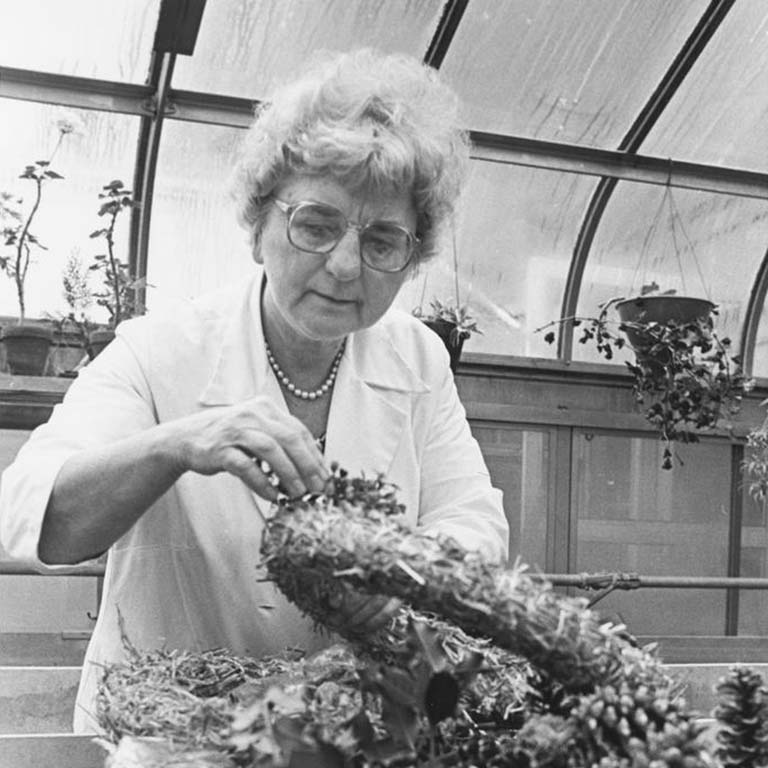Shalucha’s career began in the early 1940s as an instructor in the children’s gardening program at the Brooklyn Botanical Gardens. At the time, formalized science education was still a relatively new concept in American public schools, and the nation was evolving from a rural, agricultural society to an urban, industrialized one. Shalucha, with an inborn love of nature and passion for gardening, worried that kids living in high-rise apartments and playing on the sidewalks of teeming cities were losing touch with their natural surroundings. Years later, Shalucha recalled how her experience in Brooklyn shaped her plans for Hilltop.
“I was impressed with what it did to those school kids,” she said. “They came from the concrete desert where they had never been exposed to gardening, and it excited them. Seeing the response by those kids had a deep and lasting impact on me.”
In Bloomington, Shalucha found kindred spirits in IU President Herman B Wells, a noted educational reformer, and Ralph Cleland, the civic-minded chairman of the IU botany department. The three of them shared a vision of an enduring community resource, offering both recreational and educational resources.
From the start, Shalucha defined Hilltop’s mission as “learning how to work with nature and how best to teach science to children in an outdoor garden setting.” The curriculum was designed to engage the mind and excite the senses.
Elementary school students ages 8 to 12 learned natural science by planting crops and observing their growth cycles. Aspiring science educators from IU and surrounding public schools studied innovative approaches for teaching natural science through the center’s rigorous leadership training initiative. Students of all ages were expected to get their hands dirty by performing typical gardening chores, such as digging out planting beds, pulling weeds and pruning dead branches.
“Beneath all its magic, Hilltop is also the embodiment of a dedicated philosophy” Shalucha said. “It captures the natural curiosity of its useful members and their leaders. It develops within them a scientific understanding of how the elements of nature work together, and an appreciation for the beauty of the living world.”
Hilltop quickly gained an international reputation for its pioneering approach, and Shalucha was invited to share her ideas with educators and plant scientists throughout the world. In 1985, as a delegate to the U.S.-China Scientific Exchange Program, she toured botanical gardens in Beijing, Hanzhong, Suzhou, Wuxi and Hangzhou.
“The program here is known all over the world,” she said. “When I talk about Hilltop in addressing horticultural programs in Canada, Israel, the Soviet Union and throughout Europe, it spawns similar programs in those countries.”
Shalucha’s achievements were equally celebrated at home. She was selected to serve on the advisory board of the Young Garden Council in Washington, D.C., and in 1983, Indiana Gov. Robert D. Orr named her to the Food and Agricultural Advisory Council of the White River Park Development Commission. She also developed enduring partnerships with the city of Bloomington, Bloomington Parks and Recreation Department and Bloomington Garden Club.
Although Shalucha was always quick to share credit for Hilltop’s success, her spiritual and practical guidance was indispensable to the center’s rapid growth. In Hilltop’s first year, just 14 students were enrolled. By 1957, the class had grown to 170.
More than 10,000 young learners and 4,000 teachers took classes at Hilltop during Shalucha’s 37-year tenure. The center itself grew from the approximate size of two city blocks to more than 5 acres.
And with every shovelful of dirt they turned while creating Hilltop’s legacy gardens, Shalucha and her students also broke new ground in youth science education.

 The College of Arts
The College of Arts